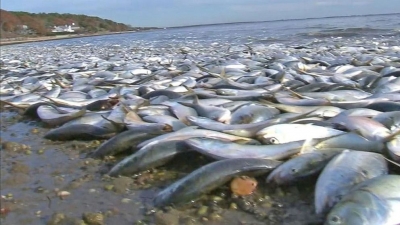
If you are a regular follower of news, you would have often come across pictures or videos of thousands of dead fish floating in a lake or a river. Sudden appearance of dead fish is a clear sign of environmental stress in the water body and it prompts officials to investigate the underlying cause. Called fish kill or fish die-off, such events can result from a variety of reasons.
Oxygen depletion
Dead zone: Most fish kills happen due to low oxygen level triggered by water pollution. Some regions in river, lakes and oceans become too depleted in dissolved oxygen that they can no longer support aquatic life. These areas are called dead zones.
When humans channel agricultural runoff, sewage and industrial effluents into waterways, the amount of nutrients in the water increases. The excess nutrients, especially nitrogen and phosphorous, lead to a spurt in the growth of microscopic algae called phytoplankton. This phenomenon is called algal bloom. Phytoplanktons use up all the nutrients, grow, die and sink to the bottom, where they are decomposed by bacteria. The bacteria respire using the dissolved oxygen in the water, leading to the depletion of oxygen available for other marine organisms, which eventually suffocate and die, mostly en masse.
Algae can also form infamous red tides, large toxin-releasing blooms that can accumulate in fish and spread through the food web.
High water temperature: Most dissolved oxygen-related fish kills occur in the summer months. In general, warm water holds less dissolved oxygen than cold water, so summer is the time when fish can have a hard time getting enough oxygen.
Other causes
Apart from oxygen, depletion, drought, overpopulation, infectious diseases, and release of high concentrated toxins into the water body cam contribute to fish kill. More often than not, fish kill is a result of a combination of several such factors.
Picture Credit : Google

